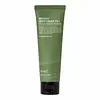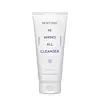What's inside
What's inside
 Key Ingredients
Key Ingredients

No key ingredients
 Benefits
Benefits

 Concerns
Concerns

 Ingredients Side-by-side
Ingredients Side-by-side

Water
Skin ConditioningMyristic Acid
CleansingGlycerin
HumectantCamellia Sinensis Leaf Water
MaskingLauric Acid
CleansingPalmitic Acid
EmollientStearic Acid
CleansingPotassium Hydroxide
BufferingButylene Glycol
HumectantPentylene Glycol
Skin ConditioningSorbitan Olivate
Emulsifying1,2-Hexanediol
Skin ConditioningPolyquaternium-10
Camellia Japonica Seed Oil
EmollientSodium Lauroyl Glutamate
Centella Asiatica Extract
CleansingSalix Alba Bark Extract
AstringentSalix Nigra Bark Extract
Skin ProtectingPanthenol
Skin ConditioningCaprylic/Capric Triglyceride
MaskingHouttuynia Cordata Extract
Skin ConditioningPunica Granatum Extract
AstringentCamellia Sinensis Leaf Extract
AntimicrobialCamellia Sinensis Seed Extract
HumectantCamellia Sinensis Root Extract
PerfumingCaprylyl Glycol
EmollientHelianthus Annuus Seed Oil
EmollientCapric Acid
CleansingRosmarinus Officinalis Leaf Oil
MaskingAllantoin
Skin ConditioningWater, Myristic Acid, Glycerin, Camellia Sinensis Leaf Water, Lauric Acid, Palmitic Acid, Stearic Acid, Potassium Hydroxide, Butylene Glycol, Pentylene Glycol, Sorbitan Olivate, 1,2-Hexanediol, Polyquaternium-10, Camellia Japonica Seed Oil, Sodium Lauroyl Glutamate, Centella Asiatica Extract, Salix Alba Bark Extract, Salix Nigra Bark Extract, Panthenol, Caprylic/Capric Triglyceride, Houttuynia Cordata Extract, Punica Granatum Extract, Camellia Sinensis Leaf Extract, Camellia Sinensis Seed Extract, Camellia Sinensis Root Extract, Caprylyl Glycol, Helianthus Annuus Seed Oil, Capric Acid, Rosmarinus Officinalis Leaf Oil, Allantoin
Water
Skin ConditioningMyristic Acid
CleansingGlycerin
HumectantPotassium Hydroxide
BufferingPalmitic Acid
EmollientStearic Acid
CleansingLauric Acid
Cleansing1,2-Hexanediol
Skin ConditioningSorbitan Olivate
EmulsifyingGlycol Distearate
EmollientCocamidopropyl Betaine
CleansingGlyceryl Caprylate
EmollientPolyquaternium-7
Sodium Lauroyl Oat Amino Acids
CleansingPolyquaternium-39
Sodium Chloride
MaskingOleic Acid
EmollientArachidonic Acid
EmollientPanthenol
Skin ConditioningAllantoin
Skin ConditioningCapric Acid
CleansingSodium Cocoyl Apple Amino Acids
Skin ConditioningButylene Glycol
HumectantHexylene Glycol
EmulsifyingTetrasodium Glutamate Diacetate
Silk Amino Acids
HumectantCaprylic/Capric Triglyceride
MaskingNelumbo Nucifera Flower Extract
Skin ConditioningCoix Lacryma-Jobi Ma-Yuen Seed Extract
Skin ConditioningMoringa Oleifera Seed Oil
EmollientDisodium EDTA
Sodium Benzoate
MaskingChlorphenesin
AntimicrobialRosmarinus Officinalis Leaf Oil
MaskingWater, Myristic Acid, Glycerin, Potassium Hydroxide, Palmitic Acid, Stearic Acid, Lauric Acid, 1,2-Hexanediol, Sorbitan Olivate, Glycol Distearate, Cocamidopropyl Betaine, Glyceryl Caprylate, Polyquaternium-7, Sodium Lauroyl Oat Amino Acids, Polyquaternium-39, Sodium Chloride, Oleic Acid, Arachidonic Acid, Panthenol, Allantoin, Capric Acid, Sodium Cocoyl Apple Amino Acids, Butylene Glycol, Hexylene Glycol, Tetrasodium Glutamate Diacetate, Silk Amino Acids, Caprylic/Capric Triglyceride, Nelumbo Nucifera Flower Extract, Coix Lacryma-Jobi Ma-Yuen Seed Extract, Moringa Oleifera Seed Oil, Disodium EDTA, Sodium Benzoate, Chlorphenesin, Rosmarinus Officinalis Leaf Oil
 Reviews
Reviews

Ingredients Explained
These ingredients are found in both products.
Ingredients higher up in an ingredient list are typically present in a larger amount.
1,2-Hexanediol is a synthetic liquid and another multi-functional powerhouse.
It is a:
- Humectant, drawing moisture into the skin
- Emollient, helping to soften skin
- Solvent, dispersing and stabilizing formulas
- Preservative booster, enhancing the antimicrobial activity of other preservatives
Allantoin is a soothing ingredient known for its protective and moisturizingg properties. Because of this, it is often added to products with strong active ingredients.
Studies show higher concentrations of this ingredient can promote wound healing.
Though it can be derived from the comfrey plant, allantoin is produced synthetically for cosmetic products to ensure purity.
Learn more about AllantoinButylene Glycol (or BG) is used within cosmetic products for a few different reasons:
Overall, Butylene Glycol is a safe and well-rounded ingredient that works well with other ingredients.
Though this ingredient works well with most skin types, some people with sensitive skin may experience a reaction such as allergic rashes, closed comedones, or itchiness.
Learn more about Butylene GlycolCapric Acid is a saturated fatty acid. It is naturally found in coconut oil and palm kernel oil. Creating capric acid involves the oxidation of decanol, a primary alcohol. This ingredient has perfuming, masking, and antibacterial properties.
Capric Acid is mainly used in perfume and to create artificial fruit flavors. Masking ingredients are used to cover the scent of another ingredient.
Interestingly, capric acid has a rancid scent on its own.
Learn more about Capric AcidThis ingredient is an emollient, solvent, and texture enhancer. It is considered a skin-softener by helping the skin prevent moisture loss.
It helps thicken a product's formula and makes it easier to spread by dissolving clumping compounds.
Caprylic Triglyceride is made by combining glycerin with coconut oil, forming a clear liquid.
While there is an assumption Caprylic Triglyceride can clog pores due to it being derived from coconut oil, there is no research supporting this.
Learn more about Caprylic/Capric TriglycerideGlycerin is already naturally found in your skin. It helps moisturize and protect your skin.
A study from 2016 found glycerin to be more effective as a humectant than AHAs and hyaluronic acid.
As a humectant, it helps the skin stay hydrated by pulling moisture to your skin. The low molecular weight of glycerin allows it to pull moisture into the deeper layers of your skin.
Hydrated skin improves your skin barrier; Your skin barrier helps protect against irritants and bacteria.
Glycerin has also been found to have antimicrobial and antiviral properties. Due to these properties, glycerin is often used in wound and burn treatments.
In cosmetics, glycerin is usually derived from plants such as soybean or palm. However, it can also be sourced from animals, such as tallow or animal fat.
This ingredient is organic, colorless, odorless, and non-toxic.
Glycerin is the name for this ingredient in American English. British English uses Glycerol/Glycerine.
Learn more about GlycerinLauric Acid is a fatty acid or lipid. About half of fatty acids in coconut oil is lauric acid.
This ingredient helps hydrate and sooth skin. As a humectant, it helps trap moisture. It also aids in cleaning and enhancing the texture of products.
Lauric acid may not be Malassezia folliculitis, or fungal acne, safe.
Learn more about Lauric AcidMyristic Acid is a saturated fatty acid. It is naturally found in milk fat. Other sources include palm oil, coconut oil, and butter fat.
Myristic Acid is an emulsifer and cleanser. As an emulsifer, it stabilizes a product by preventing ingredients from separating. Myristic Acid helps clean your skin by acting as a surfactant. It tends to gather oil and dirt on your skin to be easily rinsed away.
One study from 2021 found Myristic Acid to have anti-inflammatory properties.
Learn more about Myristic AcidPalmitic Acid is a fatty acid naturally found in our skin and in many plant and animal sources. In cosmetics, it is usually derived from palm oil. It serves many purposes in skincare, acting as a cleanser, emollient, and emulsifier.
As an emollient, palmitic acid helps soften and smooth the skin by preventing water loss. In cleansers, it helps remove oil and dirt while creating foam.
Its emulsifying properties help stabilize products by keeping water and oil-based ingredients from separating.
This may not be suitable for fungal acne-prone skin, as fatty acids like this can sometimes trigger breakouts in sensitive individuals.
Learn more about Palmitic AcidPanthenol is a common ingredient that helps hydrate and soothe the skin. It is found naturally in our skin and hair.
There are two forms of panthenol: D and L.
D-panthenol is also known as dexpanthenol. Most cosmetics use dexpanthenol or a mixture of D and L-panthenol.
Panthenol is famous due to its ability to go deeper into the skin's layers. Using this ingredient has numerous pros (and no cons):
Like hyaluronic acid, panthenol is a humectant. Humectants are able to bind and hold large amounts of water to keep skin hydrated.
This ingredient works well for wound healing. It works by increasing tissue in the wound and helps close open wounds.
Once oxidized, panthenol converts to pantothenic acid. Panthothenic acid is found in all living cells.
This ingredient is also referred to as pro-vitamin B5.
Learn more about PanthenolPotassium hydroxide is commonly known as caustic potash. It is used to fix the pH of a product or as a cleaning agent in soap. In cleansers, it is used for the saponification of oils.
Sapnification is the process of creating fatty acid metal salts from triglycerides and a strong base. During this process, Potassium Hydroxide is used up and is not present in the final product.
Using high concentrations of Potassium Hydroxide have shown to irritate the skin.
Learn more about Potassium HydroxideRosmarinus Officinalis Leaf Oil is oil expressed from the leaves of the rosemary plant.
Rosemary Leaf Oil is a fragrance and helps give your product a scent. If you are sensitive to irritating fragrances, this one contains camphor. Camphor has been found to irritate skin.
This oil also contains antioxidant and antimicrobial properties. As an antioxidant, it may protect you skin against damage. This can help slow down the signs of aging.
Learn more about Rosmarinus Officinalis Leaf OilSorbitan Olivate is created from the fatty acids in olive oil and sorbitol.
This ingredient is an oil in water emulsifier. It helps stabilize a product by preventing oils and waters from separating. Sorbitan Olivate also helps hydrate the skin.
Manufacturers sell sorbitan olivate under the name OliveM 1000. OliveM 1000 a multifunctional ingredient. It is self-emulsifying. According to a manufacturer, OliveM 1000 does not disrupt natural skin biome.
Due to its olive oil base, this ingredient may not be fungal-acne safe.
Learn more about Sorbitan OlivateStearic Acid is a fatty acid. It is an emollient, emulsifier, and texture enhancer.
As an emollient, stearic acid helps soften skin. It aids the skin's protective barrier by preventing water loss. It also provides a gentle cleansing effect without stripping away natural oils.
Stearic acid may also be used to enhance the texture of products. It can add volume and stabilize ingredients such as water and oil. This can help water and oil ingredients from separating.
Sources of stearic acid include animal or vegetable fats/oils such as coconut or shea. It can be naturally found in butter, cocoa butter, shea butter, vegetable fats, and animal tallow.
This ingredient may not be Malassezia folliculitis, or fungal-acne safe.
Learn more about Stearic AcidWater. It's the most common cosmetic ingredient of all. You'll usually see it at the top of ingredient lists, meaning that it makes up the largest part of the product.
So why is it so popular? Water most often acts as a solvent - this means that it helps dissolve other ingredients into the formulation.
You'll also recognize water as that liquid we all need to stay alive. If you see this, drink a glass of water. Stay hydrated!
Learn more about Water